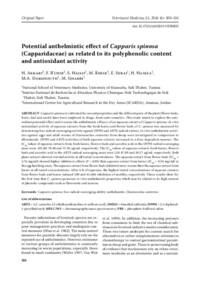Potential anthelmintic effect of Capparis spinosa (Capparidaceae) as related to its polyphenolic content and antioxidant activity

Authors:
Capparis spinosa is cultivated for several proprieties and the different parts of the plant (flower buds,
fruits, leaf and seeds) have been employed in drugs, foods and cosmetics. This study aimed to explore the antioxidant
potential effect and to assess the anthelmintic efficacy of an aqueous extract of Capparis spinosa. In vitro
antioxidant activity of aqueous extracts from the fresh leaves and flower buds of C. spinosa was measured by
determining free radical-scavenging activity against DPPH and ABTS radical cations. In vitro anthelmintic activities
against eggs and adult worms of Haemonchus contortus from sheep were investigated in comparison to
albendazole. DPPH and ABTS activities of both aqueous extracts increased in a dose dependent manner. The
IC50 values of aqueous extracts from fresh leaves, flowers buds and ascorbic acid in the DPPH radical scavenging
assay were 101.40; 70.40 and 57.56 μg/ml, respectively. The IC50 values of aqueous extracts fresh leaves, flowers
buds and ascorbic acid in the ABTS radical scavenging assay were 110; 87.89 and 58.17 μg/ml, respectively. Both
plant extracts showed ovicidal activity at all tested concentrations. The aqueous extract from flower buds (IC50 =
2.76 mg/ml) showed higher inhibitory effects (P < 0.05) than aqueous extract from leaves (IC50 = 8.54 mg/ml) in
the egg hatching assay. The aqueous extract from flower buds inhibited more worms than the aqueous extract from
leaves at all tested concentrations. After 6 h of exposure, the highest tested concentrations of aqueous extracts
from flower buds and leaves induced 100 and 41.66% inhibition of motility, respectively. These results show for
the first time that C. spinosa possesses in vitro anthelmintic properties which may be related to its high content
of phenolic compounds such as flavonoids and tannins.
